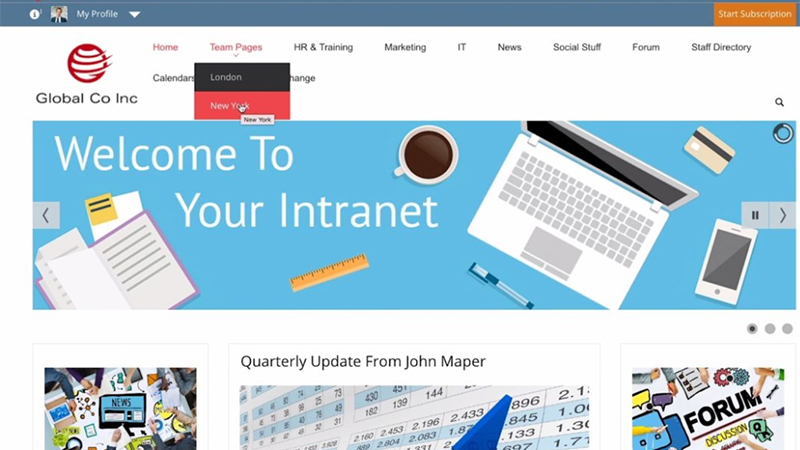What is an Intranet? Everything You Need to Know
What is an intranet? An intranet is a private network designed to promote collaboration, communication and higher performance between an organization’s employees and their roles. It serves a broad range of purposes and uses, but at its core, an intranet is there to help employees and make their jobs easier.

As a matter of fact, companies using dedicated internal communications platforms see up to a 30% increase in employee engagement. This leads to higher overall company success and a better work culture.
So, how did the intranet come to be? What are its many uses and benefits? Is it a search engine? A website? Internal communications tool? Or is it more like an enterprise social network?
We’ll be clarifying this and more in today’s article. If you’re an office manager and are unsure if an intranet is right for you, listen up.
The History of the Intranet
Intranets first stepped into the digital scene in the 1990s, around the same time the World Wide Web blew up and changed the way companies work and communicate forever. During this time, the intranet was a singular welcome page for a company. It contained essential, basic company information in the form of flat, text-heavy pages with the traditional blue hyperlinks. The purpose of the intranet during this time was to deliver basic company communications.
By the mid-late 1990s, the intranet developed into a clunky document management system (DMS).
Next came the 2000s. By this time, help desk features were introduced to the intranet, enabling users to find colleagues on the employee directory and perform basic HR functions such as booking absences or searching for information.
Intranets began to develop more features to assist employees in their day-to-day roles. While still heavily weighted as a company information tool, intranets could now allow employees to access the information they needed quickly and effectively.
Enter the 2010s and the disruptive rise of the global phenomenon known as social media. Many intranets adopted the social media style of enabling quick and collaborative conversation in the form of group chats, comments, forums, status updates, and more. They also integrated limited blogging tools, wikis and discussion forums. Intranets also swept up developments in document management, offering better access to centralized information. As information became easier to share and conversation became more prominent, some basic, common workflows became more efficient.
Intranets, as we know them today, are essentially internal social media networks for organizations. They now give precedence to user profiles and incorporate an array of social features, such as @mentioning, #tagging, microblogging or commenting. Activity streams provide real-time insights and information. Algorithms and data analytics allow for greater personalization, recommending certain content to users.
In addition, there is an emphasis on user experience. As technology has become more complicated, more of an effort has been put into still making the platform easy to use. This functionality improves efficiency and productivity in the workplace while making it more popular among employees.
The Roles of the Intranet
Today, intranets can now embody a vast range of features and functionality, allowing them to serve a huge variety of purposes. Its functionality largely depends on the organization and its goals, users, industry, etc.
Here are some common uses of an intranet:
- Homebase for information: Hosts files of all types and can be integrated with content management systems (CMS) and document management systems (DMS) for easy access and cross-collaboration.
- Channel of communication: An intranet facilitates internal communication that is instant. It connects people within an organization globally and across timezones, building a virtual culture.
- Human resources: Preboarding and onboarding employees. Employees can also book a leave of absence, submit expenses, or do internal training.
- Company resources: Employees can have access to documents and files related to company policies or can pose questions.
- Information management: Through forums, discussion areas, idea boards, and team areas, employees can ask questions or tap into the knowledge of their peers.
- Employee engagement: Promote company culture by creating a means of communication between employees. This will help them get to know each other and engage in discussion.
Features of the Intranet
With so many functions, the intranet must be well-equipped with the proper features to complete them. What started out as a forum for management to communicate to employees from the top-down has evolved into a space that promotes instant collaboration across teams, locations, and levels of management.
Here are a few common features of the intranet:
- User profiles: As part of a company directory, often connected to an external social profile like LinkedIn and Twitter.
- Blogs and content: Informational resources for employees to learn and grow.
- Forums/discussion areas: Informal basis for collaboration between employees. They act as communities and can be segmented into specific departments, projects or even common interests. Groups can meet and collaborate ‘virtually’ to share ideas, ask questions, etc.
- Social media features: Instant messaging, newsfeeds or integration with tools like Slack, Skype, or Teamwork. Ability to follow users or @mention people alongside likes, shares, #tagging or comments.
- Accessibility: Intranets can be accessed via a browser with no program installation or via mobile for ultimate portability.
Security: Require usernames and passwords connected to the company email. Data-encrypted and within the network of the company.



